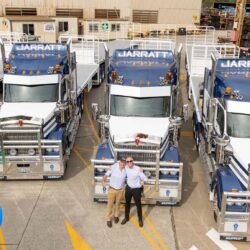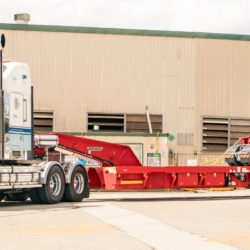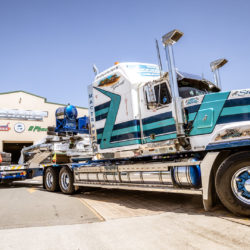In part one of this two-part series, we’re looking at the safety and productivity benefits of robotic welding in heavy equipment trailer manufacturing. Our own robotic welder, installed in 2007 is now considered an integral part of the Drake Trailers workforce, but at the time deciding to automate part of our trailer manufacturing facility was a big decision.
The idea of integrating robotic welding into the trailer manufacturing process initially sparked concern that these robot welders would result in job losses. Almost a decade later, the fears have proved to be unfounded with robotic welding demonstrating some clear advantages for trailer manufacturers in Australia and for the humans they’ve replaced at the production line – many of whom are now using their skills in more rewarding ways.
The two main types of robotic welders are articulating robots and rectilinear robots.
- Articulating robots employ rotating joints and arms, creating an irregularly shaped working zone
- Rectilinear robots move in a line across any of three axes and can also provide rotational movement using a wrist-like joint that creates a box-shaped work-zone.
The rectilinear welding robot is the most common form used by Australian trailer manufacturers
Safety benefits
Welding is dangerous work. The latest statistics available from Safe work Australia state that of all occupations, fabrication engineering trades, including welding accounted for 5,620 serious claims in 2013/14. Dangers associated with traditional welding methods include:
- electric shock,
- toxic fumes and gases – inhaling manganese can cause very serious damage to your brain and nervous system and if welding is done near solvents containing chlorinated hydrocarbons, the ultraviolet light can react with the solvents to form phosgene gas, which is deadly even in small quantities.
- respiratory problems as breathing in iron oxide irritates nasal passages, throat, and lungs.
- Fire and explosions
- ‘welder’s flash’ – also known as corneal burn caused by ultraviolet light exposure that permanently damages the eye’s cornea.
New technology aimed at improving worker safety has historically been widely supported by trailer manufacturers across Australia and now that robotic welders are a standard feature of the workshop landscape, having proven their worth in terms of improved safety for one of the most high risk places on the production line.
And while robotic welders may have replaced traditional welders in the most dangerous areas of the production process, there will always be roles for highly qualified welding tradespeople in the design and manufacture of heavy equipment, where there remains a high degree of customisation.
Productivity benefits
Productivity is often the starting point when weighing up the advantages of automation and with robotic welding, there’s no doubt that productivity has improved. A key benefit for trailer manufacturers in Australia is that the speed of a robotic welder drives down the unit cost – allowing local manufacturers to compete with cheaper imports – more important than ever as we move to the end of the resource boom.
The benefits of robotic welding don’t stop there – in Part 2 we’re going to look at how the quality of the end product has also improved.
At Drake Trailers, we’re passionate about the way we build the best trailers for Australian conditions. To find out more about how our robotic welder is helping us manufacture our industry-leading range of heavy equipment trailers, contact us.



